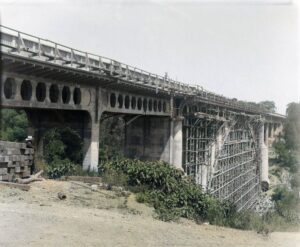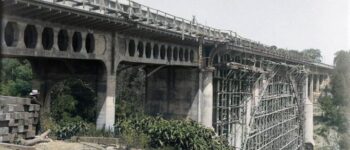1910: Grafton Bridge
April 25, 2023
By AHNZ
 Today in Auckland history, 25 April, 1910, Grafton Bridge opened. Made of concrete and steel, it was the largest reinforced concrete arch in the world at the time¹. This was what construction was like in New Zealand before bureaucratic inefficiency really set in. The project took only 2 years and was done before the technology and techniques of our current era were adopted.
Today in Auckland history, 25 April, 1910, Grafton Bridge opened. Made of concrete and steel, it was the largest reinforced concrete arch in the world at the time¹. This was what construction was like in New Zealand before bureaucratic inefficiency really set in. The project took only 2 years and was done before the technology and techniques of our current era were adopted.
As Heritage New Zealand notes, Grafton Bridge was one of the last projects of the Colonial era. Or, to put it another way, one of the very first projects of the Dominion of New Zealand era. A feat of engineering like this in our modern era would take much longer and cost much more and only Central Government in Wellington could possibly be permitted to undertake it. Grafton Bridge was paid for by Auckland ratepayers under the leadership of their mayor, Arthur Myers, at a time when Auckland City was no ‘Super City’ but one of many neighboring boroughs and municipalities.
Mayor Myers apparently had a penchant for converting rough gullies of bush and scrub into useful space. Grafton Gully, aka Cemetery Gully, got the great bridge. Out of the “overgrown gully”² and six acres of slum land”³ down the hill from Queen Street he made Myers Park. Auckland City, thanks to Meyers’ term of only 4 years, was converted from primitive organism to an evolved modern kind of corporate animal. Bridging wasn’t all. Meyers also updated Auckland with drainage, water supply, electricity, abattoirs, and the Town Hall (including the clock which Meyer donated.) Meyers balanced the books. He also became an MP and Minister where he promoted conscious town planning for New Zealand of the sort he knew first hand.
Myers’ “…mayoralty had marked a new phase in Auckland’s administration. He was an innovator with the vision and the skills to cope with the problems thrown up by the largest and most rapidly growing city in New Zealand.” Ref. Ref. Te Ara On 25 February, 1909, Myers resigned the mayoralty and left New Zealand to take a world tour. Surely there must be more to this story? Who simply resigns mid-term? Politicians these days hold on to their power for grim death and only failure at the polls or the exposure of one of their scandals puts an end to them. Could it really be that Meyer simply let go?
“The official opening of the Grafton bridge has been fixed for 3 p.m. next Thursday. As this is a citizens’ matter, the Council has not issued any special invitations, the ceremony being open to all who choose to attend..A. M. Myers, during whose term of office the work was started, will then make a few remarks, after which the contractors will formally hand over the bridge to the Council, and present to the Mayoress a pair of silver scissors. Mrs. Grey will then cut the ribbon, and the Mayor will declare the bridge open to the public. The Mayor and Councillors will then be driven across the bridge.” – Auckland Star (1910,) Papers Past
“Since Auckland’s Grafton Bridge opened in 1910 it became a place to be used by many of the town’s down and out population who wanted to end their life by jumping from it. To deter the suicidal, a new safety fence, described as “unsightly chicken netting” by one ratepayer, was installed in July, 1937.During bridge reinforcing in 1957, the old “suicide screens” were replaced, although they did not completely stop jumpers, they just made it a little harder.Despite objections from healthcare organizations, Auckland City Council removed the mesh screens from Grafton Bridge in 1996.Quite suddenly, the number of suicide attempts on the bridge, successful and unsuccessful, went up, rising five-fold, according to an Otago University Study. Health authorities lobbied for the replacement of the barriers but it took the council until 2001 to initiate the project.”“The glass screens received a Design Award in 2007.” – New Zealand: History & Natural History, Facebook (2019)
Back in 2002 I used to love the view north over the harbour from this bridge on my walk in to ‘town’. Then, suddenly, they put these ugly screens were installed (and at great expense.) And that was when you could still see through them! These days the Suicide Barriers are too filthy and we’ve lost the view from Grafton Bridge.
I remember wondering at the time- why don’t people just jump off the Symonds Street bridge a few hundred meters away? No barriers there.
As it turns out the bridge’s Suicide Screens have gone up and down several times over the years. They may serve as a barometer for suicidality in Auckland.
“Sorry to hear your view was obscured in an effort to stop people killing themselves, get well soon x” – Sam Hume, Facebook comment
Ah, but we don’t share that assumption at all.
Million dollar glass doesn’t stop people being suicidal, just obscures the problem by relegating it to somewhere we don’t have to look at it. Out of sight, out of mind. There’s another bridge down Symonds St with as much of a deadly fall only 300m or so away with no barriers at all.
This glasswork doesn’t deal with suicide, only treats the symptoms. For which we give ourselves a bloody Design Award!
New Zealand has a suicide problem. That’s a People Problem. Yet we spend upwards of $900,000 putting up a glass dome to divert the suicides and give ourselves a design award for it. Does that seem right to you?
1 Ref. Te Ara
2 Ref. Wiki
3 Ref. Te Ara
4 thoughts on "1910: Grafton Bridge"
Leave a Reply
 Like Comment Share
Like Comment Share






I read once that Myers and his men had a vision of wide streets, perhaps the “quarter acre paradise”. which explains the older residential streets even Ponsonby are narrow and newer ones such as Waterview are wide with big sections for familys. Dame Cath presided over the later infills and subsequent breakdown of social standards.
I had a Taxi at the time, Auckland was such a wonderful city in harmony with its population, the traffic was manageable and most days a half hour trip to the Airport.
About this time I picked up , at the Airport an about 30 year old American, who then hired me to drive him around and show him the sights. One stand out comment from him was to see Queen st before the old buildings were gone. I thought he was bonkers, at the time. This was about 1985.
I’d be quite keen to write about Tizard’s era but the history is in that tricky zone. Too old for internet and too new for history books.
We bought a house in Waterview in 1982, The Sandringham real estate man showed us dozens of houses, all affordable for first homers. About 1984 the house next to us was sold and two extra dwellings erected on cross lease.
Tizard mayor – 1983-90.
Labour Govt – 1984-87.
Stockmarket crash- 19.10.1987.
We kept our house but lost my job and savings/investments in the crash.
My point is, as so many homes were available why was infill housing started. Auckland was a great city in harmony with nature, green was real and meant keeping green spaces and trees. Tizard presided over the destruction.
Thanks for that. I’ve got something to build my knowledge on now for this topic